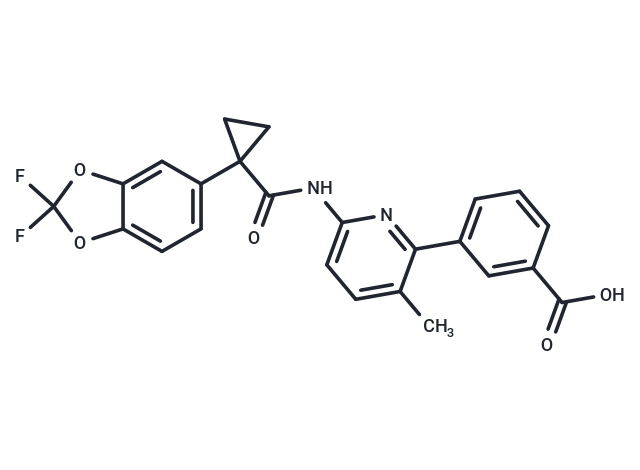Shopping Cart
- Remove All
 Your shopping cart is currently empty
Your shopping cart is currently empty

Lumacaftor (VRT 826809) is a CFTR modulator that corrects the folding and trafficking of CFTR protein. It enhances F508del-CFTR protein maturation in FRT cells (EC50: 100 nM).

| Pack Size | Price | Availability | Quantity |
|---|---|---|---|
| 5 mg | $43 | In Stock | |
| 10 mg | $61 | In Stock | |
| 25 mg | $75 | In Stock | |
| 50 mg | $98 | In Stock | |
| 100 mg | $125 | In Stock | |
| 500 mg | $313 | In Stock | |
| 1 mL x 10 mM (in DMSO) | $48 | In Stock |
| Description | Lumacaftor (VRT 826809) is a CFTR modulator that corrects the folding and trafficking of CFTR protein. It enhances F508del-CFTR protein maturation in FRT cells (EC50: 100 nM). |
| Targets&IC50 | F508del CFTR:0.1 μM (EC50, Fischer rat thyroid cells) |
| In vitro | In cultured human bronchial epithelial cells isolated from patients with CF homozygous for F508del, Lumacaftor (VX-809) improved F508del-CFTR processing in the endoplasmic reticulum and enhanced chloride secretion to approximately 14% of non-CF human bronchial epithelial cells (EC50: 81 nM), a level associated with mild CF in patients with less disruptive CFTR mutations [1]. VX-809 produced a concentration-dependent increase in the HRP luminescence signal after incubation with cells at 37°C or 27°C in both cell lines, with a similar EC50 value of approximately 0.3 μM [2]. |
| Kinase Assay | In one set of assays, R1070W-?F508-CFTR-HRP (R1070W-HRP)–expressing CFBE41o? cells were incubated with 100 μl medium containing 25 μM test compounds and 0.5 μg/ml doxycycline for 24 hours at 37°C. In a second set of assays, ?F508-CFTR-HRP (?F508-HRP)–expressing CFBE41o? cells were incubated with 100 μl medium containing 25 μM test compounds, 2 μM VX-809, and 0.5 μg/ml doxycycline for 24 hours at 37°C. All compound plates contained negative controls (DMSO vehicle) and positive controls [2 μM VX-809]. In both assays, the cells were washed four times with PBS, and HRP activity was assayed by the addition of 50 μl/well of HRP substrate. After shaking for 5 minutes, chemiluminescence was measured using a Tecan Infinite M1000 plate reader (Tecan Groups Ltd, Mannedorf, Switzerland) equipped with an automated stacker (integration time, 100 milliseconds). Z′ is defined as = 1 ? [(3 × standard deviation of maximum signal control + 3 × standard deviation of minimum signal control)/absolute (mean of maximum signal control ? mean of minimum signal control)] [2]. |
| Cell Research | FRT, HEK-293, or HBE cells expressing CFTR or F508del-CFTR were incubated for 24 h at 37 °C with or without VX-809 in the assay media. After incubation, cells were harvested in ice-cold D-PBS solution (without calcium and magnesium) and pelleted at 1,000 × g at 4 °C. Cell pellets were lysed in 1% Nonidet P-40, 0.5% sodium deoxycholate, 200 mM NaCl, 10 mM Tris, pH 7.8, and 1 mM EDTA plus protease inhibitor mixture (1:250) for 30 min on ice. Lysates were spun for 10 min at 10,000 × g at 4 °C to pellet nuclei and insoluble material. Approximately 12 μg total protein was heated in Laemmli buffer with 5% β-mercaptoethanol at 37 °C for 5 min and loaded onto a 3% to 8% Tris-acetate gel. The gel was transferred to nitrocellulose and processed for Western blotting by using monoclonal CFTR antibody 769 or polyclonal to GAPDH. Blots were developed by enhanced chemiluminescence. Quantification of the relative amounts of bands C and GAPDH was performed by using NIH ImageJ analysis of scanned films [1]. |
| Alias | VX-809, VRT 826809 |
| Molecular Weight | 452.41 |
| Formula | C24H18F2N2O5 |
| Cas No. | 936727-05-8 |
| Smiles | Cc1ccc(NC(=O)C2(CC2)c2ccc3OC(F)(F)Oc3c2)nc1-c1cccc(c1)C(O)=O |
| Relative Density. | 1.517g/cm3 |
| Storage | Powder: -20°C for 3 years | In solvent: -80°C for 1 year | Shipping with blue ice. | ||||||||||||||||||||||||||||||||||||||||
| Solubility Information | H2O: < 1 mg/mL (insoluble or slightly soluble) Ethanol: 6 mg/mL (13.26 mM), Sonication is recommended. DMSO: 50 mg/mL (110.52 mM), Sonication is recommended. | ||||||||||||||||||||||||||||||||||||||||
Solution Preparation Table | |||||||||||||||||||||||||||||||||||||||||
Ethanol/DMSO
DMSO
| |||||||||||||||||||||||||||||||||||||||||

Copyright © 2015-2025 TargetMol Chemicals Inc. All Rights Reserved.